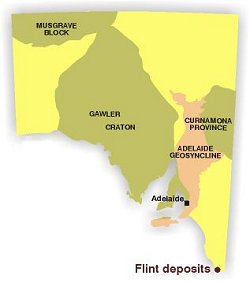 Flint, cryptocrystalline chalcedonic silica (SiO2), is used as a component in ceramic blends to make bone china, earthenware, and ceramic tiles. Because of its toughness, flint is also used as a grinding medium in ball mills in the mining, ceramics and chemical industries, but is subject to increasing competition from synthetic grinding media.
Flint, cryptocrystalline chalcedonic silica (SiO2), is used as a component in ceramic blends to make bone china, earthenware, and ceramic tiles. Because of its toughness, flint is also used as a grinding medium in ball mills in the mining, ceramics and chemical industries, but is subject to increasing competition from synthetic grinding media.
Flint occurs in the Gambier Limestone as nodular masses at shallow depth. Erosion of the limestone by the sea along a 30 km stretch of cost from Port MacDonnell then NW to Carpenter Rocks has concentrated extensive flint deposits along the beaches. A small industry supplying limited Australian demand operated between the 1880s and 1985.
Recorded resources for areas that have been held under tenure are around 140,000 tonne from which an estimated 45,000 tonne has been mined. The major operation was Middle Point Flint, with an estimated resource of 80,000 tonne of which approximately half was worked. Peak activity was during World War II with production of 2,800 tone per annum. There is some replenishment of resources during storms, also unrecorded resources between areas of tenure.
Additional reading
Flint DJ, Flint RB and Flintoft MW 1989. The flint report. Report Book 89/52. Department of Mines and Energy South Australia.


